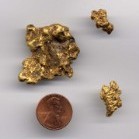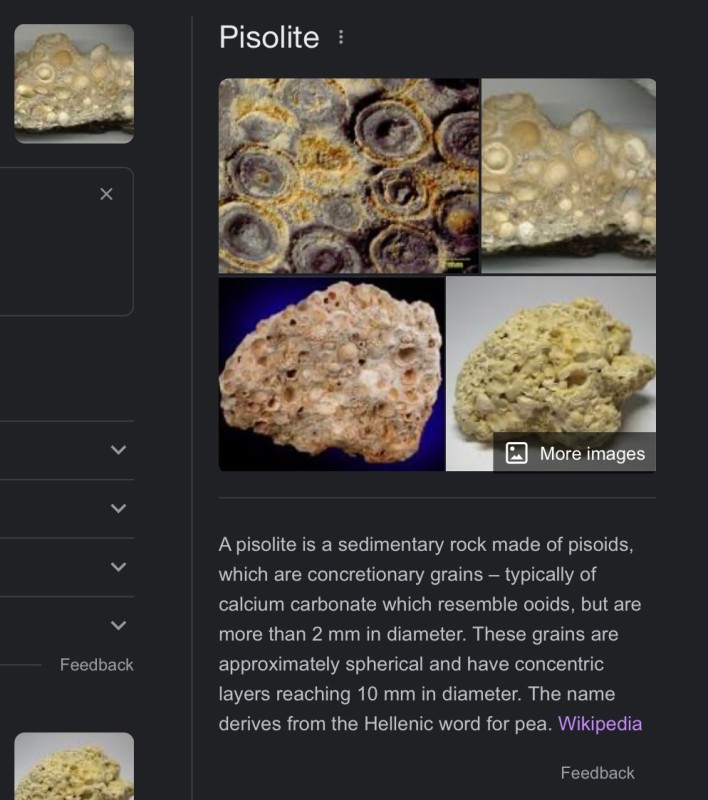-
Posts
339 -
Joined
-
Last visited
Content Type
Forums
Detector Prospector Home
Detector Database
Downloads
Everything posted by Geologyhound
-

Help Me Identify This Strange Looking Rock
Geologyhound replied to casi's topic in Rocks, Minerals, Gems & Geology
Where did you find it? Also, is that texture throughout the whole rock or is it just a surface coat? One of the pictures makes it appear like it might just be an orange crust on the surface of the rock. If the surface texture is throughout the whole rock, then I would say it’s a pisolitic limestone (pictures attached). If it is just a surface crust, then it could be a dried out algal slime, or possibly (depending on where you found it), a caliche crust. -

Need Help With My Whites Eagle Spectrum
Geologyhound replied to Josh's topic in White's Metal Detectors
My primary detector has been a White’s Spectrum XLT for over 20 years. Looking to upgrade but haven’t done so yet. Not sure how closely the display correlates to the Eagle Spectrum. I once hunted a site which had been an old store. The floor had been wood slabs with rope to seal the joints. The rope was missing in many spots before they tore the store down. They dumped the trash through a trap door in the floor and let the tide wash it out. This was nothing but solid nails and junk along with a lot of old bleach bottles and an occasional medicine bottle. I had to jack my recovery speed up and do short quick sweeps. It was a terrible racket, but whenever I would go over a coin, I would get a high spike on the good side of the screen (along with all the trash smear lines). I would pinpoint as best as possible by even shorter sweeps, then just start digging until I would get a good signal in my cup (and a pile of nails on the side). Came up with some old silvers, nickels and pennies that day and learned a lesson about recovery speed. Wouldn’t want to try that in non-trashy environments however, as I would lose depth. -
Scrape some of the black flow looking stuff on some unglazed porcelain. If it leaves a bright red to dark red streak, it is boytryoidal hematite. If the streak is brownish black, then it could be psilomelane.
-
The textured surface makes me think bone fragment. Once fossilized, fossils (like any rock) can be fractured and the fracture can then be filled and “healed” over time. I am guessing the dark shiny surface is either a coat of desert varnish, or wind/sand polish. I have found fossil vertebrae with similar black, shiny surfacing along the Oregon coast.
-
Definitely have some common crinoid columnals in the white limestone. They typically look like a fossilized stack of small poker chips. 😄 This type of crinoid was a filter feeder and was anchored to the sea bottom by the column “spine”. I concur the yellowish one looks like quartzite.
-
Some of it looks like furnace slag or glass foundry slag. The black crystal could be smoky quartz. Is it six sided? If so, does it have striations (multiple parallel lines) on the prism (side) faces? If so, are the striations parallel to the long axis, or perpendicular to the long axis? If the striations are perpendicular to the long axis then it is smoky quartz. Oddly enough, quartz crystals sometimes display rare crystal faces where the corner of the prism faces meet the termination faces. If present, these rare faces can increase the value of a crystal to collectors.
-
Is the rock calcareous? If you put dilute hydrochloric acid (0.1 molar) on it would it fizz? If so it would be a limestone with shells or at least shell replacements (shells dissolved away and the void space was then filled later). If it is not calcareous, then it is more likely a volcanic tuff or possibly a debris flow deposit. It looks like there are a lot of vesicles (air pockets in a volcanic rock), so I am leaning towards a tuff. In this case the lighter colored material would be whatever surrounded the volcanic vent and got ripped up in fragments during an eruption. The heat and force of the eruption could deform the included clasts. If the rock is from a debris flow, then the lighter colored inclusions could literally be chunks of mud that were eroded during the flow.
-

Need Help Identifying Rock
Geologyhound replied to mlkgeo's topic in Rocks, Minerals, Gems & Geology
My first inclination is that the softer and lighter colored parent rock was fractured and the fracture was filled with the darker and harder material before this rock was separated from the original outcrop. This can happen with sedimentary and igneous rocks by different methods. As jasong mentioned, the rounding of the parent rock likely occurred by tumbling in a river or stream. I’ve also seen this kind of shape when an asphaltic layer with some included iron fragments picks up mud and rusts it all together into an iron concretion. But based on the picture, I think your rock is a weathered chunk of a filled fracture. -

Need Help Identifying Rock/mineral
Geologyhound replied to matt0550's topic in Rocks, Minerals, Gems & Geology
I am curious where and when you picked up this rock. The where and when may help identify the type of rock and the process which may be responsible. Obviously a picture is not the best substitute for a rock in hand with a 10 power hand lens. That being said, my initial guesses for type of rock would be shale, basalt or amphibolite. The fact the rock split so nicely makes me inclined to think it is a sedimentary rock like shale which would have planar partings. It is possible for fracture surfaces in other rocks to imitate shale partings at least on a small scale. My guess is the orange material is actually a hydrated iron oxide like limonite and goethite. A limonite/goethite crust would be relatively soft and could probably be rubbed or scraped off. These minerals would be deposited in the fracture or parting when water and iron minerals, or iron sulfide minerals, are present. Basically, when water is under pressure in the pore space of a rock it can hold more minerals and solution. When such water enters a fracture, the pressure drop means water can longer hold as much minerals in solution, and minerals are deposited in the fracture or parting. As I’m sure you are aware, when water freezes it takes up more space. As such “Frost – jacking“ is a major component in mechanical weathering of rocks. Pre-existing features like parting planes in sedimentary rocks or fractures are ideal locations for water accumulation. When this water freezes, it jacks the rock apart. Take a close look at your rock and see if the “crystal shadows” are actually just absence of the orange material. If so, I have to wonder if what you’re looking at is actually more recent ice crystal formation pushing or washing off some of the limonite in the fracture or parting as the rock was finally “jacked“ apart by the ice crystals. Again, without the rock actually in hand, I am guessing. -

Where's The Go Terrain App For Us Here In Us?
Geologyhound replied to Glenn in CO's topic in XP Deus II Forum
Air photos can be collected by many different companies or government agencies. As such there is no one central location for the most current air photos of any particular location. I agree with CPT_GhostLight that Google Earth is very useful. Depending on your location, Bing maps (bing.com/maps) may also be useful - especially if you have Birdseye coverage. Over here in the states, various State agencies may also keep online air photo libraries - especially those that deal with soil and groundwater contamination issues - for example the Indiana Department of Environmental Management or the Ohio Department of Natural Resources. The US Department of Agriculture - Farm Service Agency also posts airphotos, but they are still posting for 2021 and 2022 is not yet available. You may need to do some Internet research to see if Spain has an equivalent government agency. For environmental work, various firms offer historical air photo packages for sale. However that is typically on a per-site basis and may cost more than you want to spend for recreational detecting. Environmental Data Resources (EDR) would be one vendor here in the states. Again, all of these sources are simply going to have the most recent air photo available to them. There is no guarantee that is recent enough for your needs. Good luck! -
Thanks! I graduated from OSU in ‘93 (geology), so we were there at the same time. Although some of the settings appear to have different names, it looked like there were a lot of similarities between the XLT and the Deus 2 - at least as far as the menu options. Of course I am only judging the Deus 2 by the manual - I haven’t gotten one yet.
-
Beautiful stone, and you captured the star very nicely! As an Oregon State grad, I may have been in that park (but probably before I got a metal detector...). I have been swinging an XLT for the last 25 years or so and I’m looking to upgrade. I’ve pretty much decided on the Deus II with a 9” coil. I understand the tether and remote connection are issues. However, I noticed you’re an old XLT user, so I wanted to ask what are the main issues you had transitioning to the Deus II?


